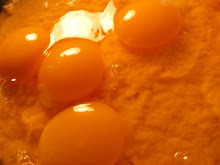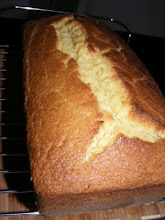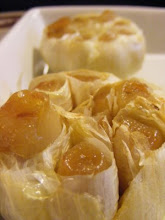Yeah, I know, barbeque chicken...BIG DEAL! And you're right, it isn't a big deal. In fact, I seldom make barbecue chicken; I prefer other ways to finish chicken off on the grill other than with BBQ sauce. BUT...good barbecue isn't that simple and I've written about that here before on Livingston Cooks. I wanted to go through the process again here with the simplest and most recognizable of grilled foods: BBQ'd Chicken.
As you will remember, I now prefer charcoal to gas. I have a killer gas barbecue that I never use. It has to be re-jetted, but that's beside the point; the food cooked over coals tastes about 100 times better than over a gas flame. And as you may recall, I have a small coal barbecue that I use that cost about 100 times less than the mammoth stainless steel one that sits idle. If I had it to do all over again, I would get a really good coal barbecue, but my plan is to rejet the gas barbecue and use it for spit cooking and roasting larger cuts of meat and continue to use my little one for the smaller ones.
Well...enough blathering about that for now.
When grilling over coals, the first thing you must do is stack the coals in a mound. This helps them to stay all snuggly and warm together until they have officially lit. That is, they need to be piled together to contain heat until they are burning hot enough to cook over. To start the coals, douse with igniting fuel and light. POOF...you have just lit your hair on fire!
As you will remember, I now prefer charcoal to gas. I have a killer gas barbecue that I never use. It has to be re-jetted, but that's beside the point; the food cooked over coals tastes about 100 times better than over a gas flame. And as you may recall, I have a small coal barbecue that I use that cost about 100 times less than the mammoth stainless steel one that sits idle. If I had it to do all over again, I would get a really good coal barbecue, but my plan is to rejet the gas barbecue and use it for spit cooking and roasting larger cuts of meat and continue to use my little one for the smaller ones.
Well...enough blathering about that for now.
When grilling over coals, the first thing you must do is stack the coals in a mound. This helps them to stay all snuggly and warm together until they have officially lit. That is, they need to be piled together to contain heat until they are burning hot enough to cook over. To start the coals, douse with igniting fuel and light. POOF...you have just lit your hair on fire!
 Here the coals have been stacked and ignited. The edges are white and you can see a nice glow in the center of the pile of coals. At this point the heat above the coals is warm enough to warm your hands over, but useless to cook over. If you stuck your finger into the coals, however, your eyes would definitely water! So, uhh...don't be doing that!!
Here the coals have been stacked and ignited. The edges are white and you can see a nice glow in the center of the pile of coals. At this point the heat above the coals is warm enough to warm your hands over, but useless to cook over. If you stuck your finger into the coals, however, your eyes would definitely water! So, uhh...don't be doing that!!
Here you get a closer look at the hot center of the coals. This is where the work is being done in getting the temperature up for cooking. The fire spreads to all of the other coals and when they are white, they are ready to cook over.
 The coals are pretty hot at this point and if you were to hold your hand over them for more than 30 seconds, you would have yourself a pretty crispy stump left in its place. These coals are ready to be spread out into a bed for cooking.
The coals are pretty hot at this point and if you were to hold your hand over them for more than 30 seconds, you would have yourself a pretty crispy stump left in its place. These coals are ready to be spread out into a bed for cooking. The coals are spread out evenly and the grill is placed over them to warm up. Now we're ready to cook the chicken.
The coals are spread out evenly and the grill is placed over them to warm up. Now we're ready to cook the chicken. Chicken thighs - bone in and skin on - are my choice for the night. I like dark meat and I think the thigh is the juiciest part of the chicken. The important thing to remember when grilling chicken is to COOK IT OVER A LOW HEAT. This is because chicken has to be well done and it is prone to flair ups which will burn the outside to a crisp while leaving the inside raw. I'll get to that in more detail in a moment, but here is a guideline for grilling meats:
Chicken thighs - bone in and skin on - are my choice for the night. I like dark meat and I think the thigh is the juiciest part of the chicken. The important thing to remember when grilling chicken is to COOK IT OVER A LOW HEAT. This is because chicken has to be well done and it is prone to flair ups which will burn the outside to a crisp while leaving the inside raw. I'll get to that in more detail in a moment, but here is a guideline for grilling meats:- Steaks and chops - cook over the hottest flame possible. This includes beef, lamb and pork. A hot flame will enable you to serve a rare steak that is sizzling and browned on the exterior.
- Fish - medium to very high flame. Fish is delicate so it's important to oil it up before it hits the grill, but depending how delicate the fish is, you should try to move it as little as possible.
- Chicken and fowl - small cuts like thighs, legs and breasts are best cooked over a low flame. Whole birds are cooked over a medium to low flame also. A rotisserie is needed for roasting whole birds unless you roast it on the cold side of a larger barbecue.

I season the chicken with a little olive oil, sea salt, crushed dried chipotle chile and paprika. Now the chicken is ready for the grill!!
 PSSSSSS!!! That's the sound a hot grill should make when meat is placed on top of it. A hot grill will not allow meat to stick to it. If there is one thing you ever learn about cooking meat on a grill is should be to get it hot enough prior to putting meat on it.
PSSSSSS!!! That's the sound a hot grill should make when meat is placed on top of it. A hot grill will not allow meat to stick to it. If there is one thing you ever learn about cooking meat on a grill is should be to get it hot enough prior to putting meat on it. 
After the chicken hits the grill, I close the lid as well as the bottom vent. This will cool the fire off so I can cook the chicken without setting it aflame. When I put my chicken on the hot grill, it immediately began to flame up. The fire was too hot. But I wanted to brown the chicken quickly and reduce the heat for a slow cook so I had to put the brakes on the heat. This is easier to do with gas by just turning a knob, but by reducing airflow feeding the coals, you can manipulate the flame as easily.
The other advantage to closing the lid - and really the most import and reason - is to trap in all of the smoke so the smoky flavor is imparted to the meat. That's the real reason why coals are superior to gas. It's the smoke that makes the difference!!!!
The other advantage to closing the lid - and really the most import and reason - is to trap in all of the smoke so the smoky flavor is imparted to the meat. That's the real reason why coals are superior to gas. It's the smoke that makes the difference!!!!
 As you can see, the smoke is just blasting out of the top vent. This is because the flame is still quite hot.
As you can see, the smoke is just blasting out of the top vent. This is because the flame is still quite hot. I close the top vent which also cools the flame further. It also traps in more smoke. Think of this little barbecue as a smoker as well as a grill. I can't stress enough the difference in flavor smoke makes (and perhaps I'm beating it to death) but airflow = smoke control which = flavor.
I close the top vent which also cools the flame further. It also traps in more smoke. Think of this little barbecue as a smoker as well as a grill. I can't stress enough the difference in flavor smoke makes (and perhaps I'm beating it to death) but airflow = smoke control which = flavor. You can see that the flame is much cooler now as I have opened the top vent and only a small amount of smoke is blowing out of the top. This is a nice slow fire for slow cooking chicken and it provides enough smoke as well.
You can see that the flame is much cooler now as I have opened the top vent and only a small amount of smoke is blowing out of the top. This is a nice slow fire for slow cooking chicken and it provides enough smoke as well.  The chicken is about half done here and you can see it is golden brown. I continue to cook it out until it is about 3/4 done before applying BBQ sauce. Adding BBQ sauce too early will make the sauce burn. This is because BBQ sauce is sugar based and the sugars will caramelize and burn is added too early.
The chicken is about half done here and you can see it is golden brown. I continue to cook it out until it is about 3/4 done before applying BBQ sauce. Adding BBQ sauce too early will make the sauce burn. This is because BBQ sauce is sugar based and the sugars will caramelize and burn is added too early. A liberal amount of sauce is added. The lid is closed and the sauce is allowed to "set up" or become sticky. Whay we want to do is dry out the sauce a bit and help it stick to the chicken.
A liberal amount of sauce is added. The lid is closed and the sauce is allowed to "set up" or become sticky. Whay we want to do is dry out the sauce a bit and help it stick to the chicken. Lola made a beautiful salad of mixed baby greens tossed lightly with hazelnut oil, toasted hazelnuts, dried cranberries, Irish blue cheese, sea salt and a sprinkle of love. It was a nice light salad and I loved the oil!
Lola made a beautiful salad of mixed baby greens tossed lightly with hazelnut oil, toasted hazelnuts, dried cranberries, Irish blue cheese, sea salt and a sprinkle of love. It was a nice light salad and I loved the oil!














































































5 comments:
thanks for all your cooking wisdom! Been checking your blog out from time to time, first time I've commented, keep up the good work!
Felix
Felix:
Thank you for the note. I appreciate the feedback because it makes this whole endeavor seem worthwhile.
Tell me, where do you live? Canada?
Marko
Hi Marko!
I live in the Maritimes, Peggys Cove, Nova Scotia. It's a small fishing village but we have a lot of tourists coming through every year, you should visit us! Sure is nice to see some of your fancy recipes made to look so easy. I made your seafood boullibase with the recomendation to save the lobster shells which we certainly have lots of out this way. It was outstanding by the way. We have charters that go out deep sea fishing and we have whale watching tours too.
All I can say is please more seafood recipes, my staple of butter and garlic is getting old.
cheers! Felix
Hiya,
Bruce here again, I couldn't find hazelnut oil at the grocery store, went to Loblaws & Dominion and they don't carry it. Where did you buy the hazelnut oil? thnks
Hi Bruce:
Try looking at a gourmet grocer. We got it at Whole Foods Market. The oil is really nice and adds a light nutty flavor to a salad.
I hope you find it and give it a try.
Marko
Post a Comment